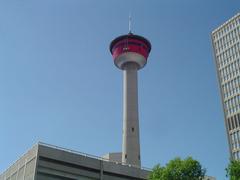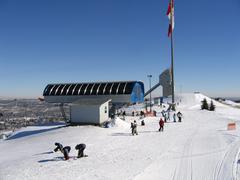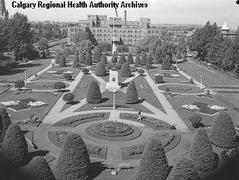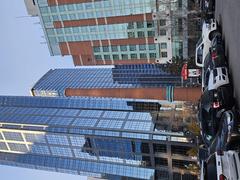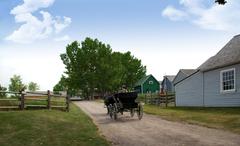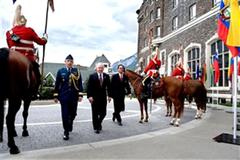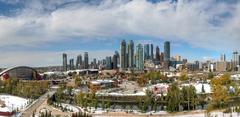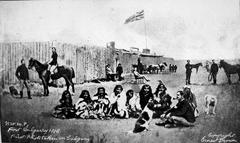
Griffith Woods Park Calgary: Visiting Hours, Tickets, and Attractions Guide
Date: 04/07/2025
Introduction: History and Cultural Significance
Griffith Woods Park is a 93-hectare natural sanctuary along the Elbow River in southwest Calgary, celebrated for its unique blend of ecological diversity, Indigenous heritage, and accessible outdoor recreation. The park preserves rare White Spruce stands, wetlands, oxbow lakes, and spring-fed streams, supporting a rich variety of flora and fauna. Its landscape is shaped by both millennia of Indigenous presence and early European settlement, with archaeological sensitivity highlighting the importance of ongoing stewardship and preservation.
Open daily from dawn to dusk with free admission, Griffith Woods Park welcomes nature lovers, families, photographers, and history enthusiasts to explore diverse trails, seasonal wildflower displays, and abundant wildlife. Educational programs, accessible pathways, and family-friendly amenities make it an inclusive destination. The park’s proximity to the Tsuut’ina Nation underscores the need for respectful visitation, honoring Indigenous lands and fostering cross-cultural conservation. Whether you seek a tranquil riverside walk or a deeper connection with Calgary’s natural and cultural heritage, Griffith Woods Park offers a living testament to urban environmental stewardship (City of Calgary, Archaeology and Calgary Parks, Parks of Calgary).
Contents
- Welcome: Discovering Griffith Woods Park
- Historical Background
- Indigenous Presence
- Early Settlement and the Griffith Family
- Ecological and Environmental Features
- Visitor Information
- Hours, Admission, and Accessibility
- Directions and Parking
- Best Times to Visit
- Attractions and Activities
- Special Events and Tours
- Conservation, Archaeology, and Community Role
- Frequently Asked Questions (FAQ)
- Conclusion and Recommendations
- References
Welcome: Discovering Griffith Woods Park
Nestled along the Elbow River, Griffith Woods Park offers a serene escape within Calgary, where history, ecology, and recreation come together. Whether you’re interested in the park’s layered past, its rare plant communities, or simply a peaceful getaway, this guide provides everything you need for a memorable visit.
Historical Background
Indigenous Presence
The land that is now Griffith Woods Park has long been a gathering place for Indigenous peoples. The Elbow River was a vital resource for water, food, and travel. Archaeological research highlights the area’s pre-contact significance, with over 30 sites identified within a kilometer of the park, demonstrating extensive seasonal and long-term use for hunting, gathering, and community life (Archaeology and Calgary Parks, p. 12). The wetlands and oxbow lakes were especially important for wildlife and resource availability.
Early Settlement and the Griffith Family
European settlement began in the late 1800s, when the land was used for ranching and agriculture. Artifacts such as glass bottles and pressed bricks found in the area indicate a continuum from Indigenous use through settler occupation. The park owes its modern existence to Wilbur and Betty Griffith, who donated the land to the City of Calgary in 2000 to ensure its protection as a natural environment park. Their legacy is celebrated today through the park’s name and ongoing stewardship (City of Calgary).
Ecological and Environmental Features
Griffith Woods Park is a haven for biodiversity. One of only two large White Spruce stands remaining in Calgary, its varied habitats include riparian forests, wetlands, oxbow ponds, and grasslands. The Elbow River’s periodic flooding supports Balsam Poplar, Trembling Aspen, and a range of wildflowers. The park is home to over 100 bird species, as well as beavers, deer, moose, and rare orchids. Its diverse native plant communities are crucial for water filtration, erosion control, and wildlife habitat (City of Calgary, Parks of Calgary).
Key Native Species
- White Spruce: Forms the park’s rare forest stands.
- Trembling Aspen: Provides early-season habitat and supports diverse wildlife.
- Rough Fescue: Essential for soil stability and winter forage.
- Prairie Crocus: Early blooming wildflower important for pollinators.
- Saskatoon Berry: Supports birds, mammals, and bears.
- Bedstraw: Helps reduce erosion and supports pollinators.
Wildlife Highlights
The park is a hotspot for birdwatching, with species such as Great Horned Owls, Boreal Chickadees, and Belted Kingfishers. Wetlands support beavers, frogs, and waterfowl, while moose, deer, and coyotes occasionally roam through the forested areas.
Visitor Information
Hours, Admission, and Accessibility
- Open: Year-round, dawn to dusk
- Admission: Free
- Accessibility: Main trails are flat, paved, and suitable for wheelchairs and strollers. Some natural trails may be uneven; check trail maps for detailed accessibility.
Directions and Parking
- Location: 45 Discovery Ridge Link SW, Calgary, Alberta
- Parking: Free parking at the main entrance; additional parking at Discovery Ridge Blvd. Carpooling or public transit is recommended during busy periods.
- Public Transit: Calgary Transit routes serve Discovery Ridge; expect a short walk from the nearest stop.
Best Times to Visit
- Spring/Summer: Wildflower blooms, active wildlife, and birdwatching.
- Autumn: Spectacular fall colors.
- Winter: Quiet snowshoeing and serene walks; sports courts double as skating rinks.
Attractions and Activities
- Trail Network: Paved and natural paths for walking, jogging, cycling, and accessible strolls.
- Discovery Ridge Pond: Beaver watching and water management education.
- Playground & Sports Courts: Family-friendly facilities near the northern entrance.
- Picnic Areas: Benches and tables throughout the park.
- Self-Guided Walking Tours: Interpretive signs and downloadable tours from the City of Calgary.
- Wildlife Viewing: Early mornings and evenings are best for spotting beavers, birds, and deer.
Special Events and Tours
The City of Calgary and local organizations occasionally offer guided nature walks and educational sessions. Visit the official park website for event schedules.
Conservation, Archaeology, and Community Role
Archaeological Sensitivity
Though no formal excavations have taken place within the park, archaeological studies underscore the area’s cultural importance. All development projects require Historic Resource Impact Assessments to protect sensitive sites (Archaeology and Calgary Parks). The park borders Tsuut’ina Nation lands, and visitors must respect boundaries to uphold Indigenous partnerships.
Conservation Initiatives
Designated as a Special Protection Natural Environment Park, Griffith Woods is managed for ecological health, wildfire mitigation, and invasive species control. Dogs must be leashed, fires are prohibited, and visitors are urged to stay on marked trails to protect habitats. Community groups and Indigenous-led programs support ongoing stewardship (MyCalgary.com).
Regional and Sustainable Tourism
The park is part of a network of natural areas along the Elbow River, benefiting from the Enmax Legacy Parks Program and aligned with regional sustainability goals, including low-carbon transportation and regenerative tourism (Clearwater Regional Park PDF, Tourism Calgary Sustainability Plan).
Frequently Asked Questions (FAQ)
Q: What are the park’s visiting hours?
A: Open daily from dawn to dusk, year-round.
Q: Is there an entrance fee or tickets?
A: No, admission is free and no tickets are required.
Q: Are dogs allowed?
A: Yes, but they must be leashed at all times.
Q: Is the park wheelchair accessible?
A: Main trails and facilities are accessible; some natural trails may be uneven.
Q: Are guided tours available?
A: Guided walks and educational programs are offered occasionally—check the City of Calgary for schedules.
Q: Can I access the park via public transit?
A: Yes, Calgary Transit serves Discovery Ridge; the park is a short walk from the nearest stop.
Q: Are fires or camping allowed?
A: No, fires and camping are strictly prohibited to protect the park’s sensitive environment.
Conclusion and Recommendations
Griffith Woods Park is a vibrant example of urban nature conservation, cultural heritage, and community recreation in Calgary. Its rare ecosystems, rich history, and accessible amenities make it a must-visit destination for locals and tourists. By respecting park guidelines—staying on trails, leashing pets, and protecting sensitive areas—visitors help preserve this remarkable space for generations to come.
Plan your visit today and immerse yourself in the beauty and heritage of Griffith Woods Park. For the latest updates, guided tour information, and maps, visit the City of Calgary’s Griffith Woods Park page. Download the Audiala app for self-guided tours and follow us on social media for more tips and updates.
References and Further Reading
- Griffith Woods Park – City of Calgary
- Archaeology and Calgary Parks
- Parks of Calgary: Native Plants
- MyCalgary.com – Griffith Woods Park
- Clearwater Regional Park Program
- Tourism Calgary Sustainability Plan

